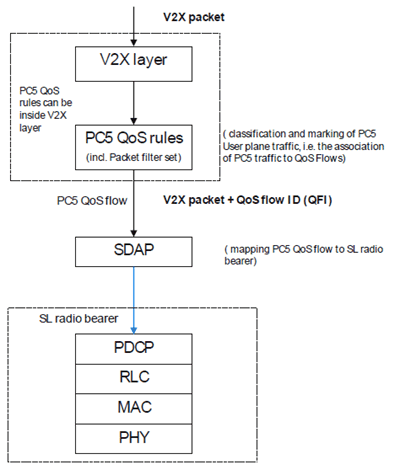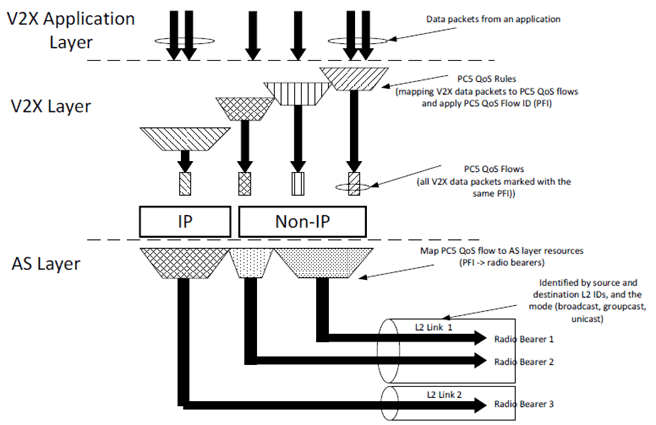Content for TS 23.287 Word version: 18.4.0
1…
4…
4.2.1.2…
4.2.2…
4.3…
5…
5.2…
5.3…
5.4…
5.4.2…
5.5
5.6…
5.7…
5.10…
6…
6.2…
6.3…
6.3.3…
6.4…
6.5…
A…
5.4 QoS handling for V2X communication
5.4.1 QoS handling for V2X communication over PC5 reference point
5.4.1.1 QoS model
5.4.1.1.1 General overview
5.4.1.1.2 Deriving PC5 QoS parameters and assigning PFI for PC5 QoS Flow
5.4.1.1.3 Handling of PC5 QoS Flows based on PC5 QoS Rules
5.4.1.1.4 PC5 Packet Filter Set
5.4.1.2 QoS handling for broadcast mode V2X communication over PC5 reference point
5.4.1.3 QoS handling for groupcast mode V2X communication over PC5 reference point
5.4.1.4 QoS handling for unicast mode V2X communication over PC5 reference point
...
...
5.4 QoS handling for V2X communication p. 27
5.4.1 QoS handling for V2X communication over PC5 reference point p. 27
5.4.1.1 QoS model p. 27
5.4.1.1.1 General overview p. 27
For LTE based PC5, the QoS handling is defined in TS 23.285, based on ProSe Per-Packet Priority (PPPP) and ProSe Per-Packet Reliability (PPPR).
For NR based PC5, a QoS model similar to that defined in TS 23.501 for Uu reference point is used, i.e. based on 5QIs, with additional parameter of Range as described in clause 5.4.2, clause 5.4.3 and clause 5.4.4. For the V2X communication over NR based PC5 reference point, a PC5 QoS Flow is associated with a PC5 QoS Rule and the PC5 QoS parameters as defined in clause 5.4.2. A set of standardized PC5 5QIs (PQI) are defined in clause 5.4.4. The UE may be configured with a set of default PC5 QoS parameters to use for the V2X service types, as defined in clause 5.1.2.1. For NR based unicast, groupcast and broadcast mode communication over PC5, Per-flow QoS model for PC5 QoS management shall be applied. Figure 5.4.1.1.1-1 illustrates an example mapping of Per-flow QoS model for NR PC5. Details of PC5 QoS Rules and PFI related operations are described in clause 5.4.1.1.2 and clause 5.4.1.1.3.

The following principles apply when the V2X communication is carried over PC5 reference point:
- Application layer may set the V2X Application Requirements for the V2X communication, using either TS 23.285 defined PPPP and PPPR model or the PQI and Range model as described in clause 5.4.4. Depending on the type of PC5 reference point, i.e. LTE based or NR based, selected for the transmission, the UE may map the application layer provided V2X Application Requirements to the suitable QoS parameters to be passed to the lower layer. The mapping between the two QoS models is defined in clause 5.4.2. For V2X communication over NR based PC5, different V2X packets may require different QoS treatments. In that case, the V2X packets shall be sent from the V2X layer to the Access Stratum layer within PC5 QoS Flows identified by different PFIs.
- When groupcast mode of V2X communication over NR based PC5 is used, a Range parameter is associated with the QoS parameters for the V2X communication. The Range may be provided by V2X application layer or use a default value mapped from the V2X service type based on configuration as defined in clause 5.1.2.1. The Range indicates the minimum distance that the QoS parameters need to be fulfilled. The Range parameter is passed to AS layer together with the QoS parameters for dynamic control.
- NR based PC5 supports three communication modes, i.e. broadcast, groupcast, and unicast. The QoS handling of these different modes are described in clause 5.4.1.2 to clause 5.4.1.4.
- The UE may handle traffic using broadcast, groupcast, and unicast mode communication by taking all their priorities, e.g. indicated by PQIs, into account as described in clause 5.4.3.3.
- For broadcast and groupcast modes of V2X communication over NR based PC5, standardized PQI values are applied by the UE, as there is no signalling over PC5 reference point for these cases.
- When network scheduled operation mode is used, the UE-PC5-AMBR for NR based PC5 applies to all types of communication modes, and is used by NG-RAN for capping the UE's NR based PC5 transmission in the resources management. The UE-PC5-AMBR shall be set to the sum of the aggregate maximum bit rate of all types of communication (i.e. unicast, groupcast and broadcast modes) over PC5 reference point.
5.4.1.1.2 Deriving PC5 QoS parameters and assigning PFI for PC5 QoS Flow p. 29
The following description applies to for both network scheduled operation mode and UE autonomous resources selection mode.
When a service data packet or request from the V2X application layer is received, the UE determines if there is any existing PC5 QoS Flow matching the service data packet or request, i.e. based on the PC5 QoS Rules for the existing PC5 QoS Flow(s).
If there is no PC5 QoS Flow matching the service data packet or request, the UE derives PC5 QoS parameters defined in clause 5.4.2 as below:
- If the application layer provides the V2X Application Requirements for the V2X service type (e.g. priority requirement, reliability requirement, delay requirement, range requirement), the V2X layer determines the PC5 QoS parameters based on the V2X Application Requirements;
- Otherwise, the V2X layer determines the PC5 QoS parameters based on the mapping of the V2X service type to PC5 QoS parameters defined in clause 5.1.2.1.
-
If there is no existing PC5 QoS Flow that fulfils the derived PC5 QoS parameters:
- The UE creates a new PC5 QoS Flow for the derived PC5 QoS parameters; and
- The UE then assigns a PFI and derives PC5 QoS Rule for this PC5 QoS Flow.
- Otherwise, the UE updates the PC5 Packet Filter Set in the PC5 QoS Rule for such PC5 QoS Flow.
5.4.1.1.3 Handling of PC5 QoS Flows based on PC5 QoS Rules p. 29
For each communication mode (e.g. broadcast, groupcast, unicast), the UE maintains the PC5 QoS Context and PC5 QoS Rule(s) for each PC5 QoS Flow identified by a PC5 QoS Flow Identifier (PFI) per destination identified by Destination Layer-2 ID.
The following information is maintained in the V2X layer of the UE:
-
A PC5 QoS Context includes the following information:
- PFI;
- PC5 QoS parameters (i.e. PQI and conditionally other parameters such as MFBR/GFBR, Range, etc.) as defined in clause 5.4.2; and
- the V2X service type(s).
-
One or more PC5 QoS Rule(s). Each PC5 QoS Rule contains the following information:
- PFI;
- a PC5 Packet Filter Set as defined in clause 5.4.1.1.4; and
- a precedence value. The precedence value determines the order in which the PC5 QoS Rules are evaluated. The PC5 QoS Rule with lower precedence value is evaluated before those with the higher precedence values.
-
To add a new PC5 QoS Flow or to modify any existing PC5 QoS Flow, the V2X layer provides the following information for the PC5 QoS Flow to AS layer.
- the PFI;
- the corresponding PC5 QoS parameters; and
- source/destination Layer-2 IDs for broadcast and groupcast mode communication, or the PC5 Link Identifier for unicast.
-
To remove any existing PC5 QoS Flow, the V2X layer provides the following information for the PC5 QoS Flow to AS layer.
- the PFI; and
- source/destination Layer-2 IDs for broadcast and groupcast mode communication, or the PC5 Link Identifier for unicast.

As illustrated in Figure 5.4.1.1.3-1, for a given pair of source and destination Layer-2 IDs, there can be multiple radio bearers, each corresponding to a different PC5 QoS level. The AS layer can determine the mapping of multiple PC5 QoS Flows to the same radio bearer based on the information provided. For broadcast and groupcast mode communication, the L2 link goes to all UEs in proximity identified by the destination Layer-2 ID.
5.4.1.1.4 PC5 Packet Filter Set p. 31
PC5 Packet Filter Set supports two types of packet filters, i.e. the V2X IP Packet Filter Set and the V2X Packet Filter Set. A PC5 QoS Rule contains either the V2X IP Packet Filter Set or the V2X Packet Filter Set.
The V2X IP Packet Filter Set has the same format as the IP Packet Filter Set defined in clause 5.7.6.2 of TS 23.501.
The V2X Packet Filter Set shall support Packet Filters based on at least any combination of:
- V2X service type;
- Source/Destination Layer-2 ID;
- Application Layer ID (e.g. Station ID).
5.4.1.2 QoS handling for broadcast mode V2X communication over PC5 reference point p. 31
When PC5 broadcast is used for the transmission of V2X service data, the following principles are followed for both network scheduled operation mode and UE autonomous resources selection mode:
- PC5 QoS parameters defined in clause 5.4.2 are applied.
- The V2X layer determines the PC5 QoS parameters based on the V2X Application Requirements (if available) or the mapping of the V2X service type to PC5 QoS parameters, as defined in clause 5.4.1.1.2.
- The V2X layer assigns a PC5 QoS Flow Identifier (PFI) and derives the PC5 QoS Rule for the PC5 QoS Flow, and associates the PC5 QoS parameters to the PFI.
- The V2X layer provides the PFI and the associated PC5 QoS parameters to AS layer for Per-flow QoS model operations.
- The V2X layer determines the PFI based on the PC5 QoS Rule for the V2X service data from the V2X application layer, and passes the V2X service data along with PFI to the AS layer for transmission.
- The UE can use the PC5 QoS parameters for PC5 QoS handling.
- The UE provides PC5 QoS information (related to PC5 QoS parameters), Destination Layer-2 ID(s) and communication mode to the NG-RAN and NG-RAN may provide AS layer configurations and configure the mapping of PC5 QoS flow to radio bearer as defined in TS 38.331 and TS 36.331.
- The UE provides PC5 QoS information (related to PC5 QoS parameters) and Destination information (related to Destination Layer-2 ID(s)) to the NG-RAN for resource request as defined in TS 38.331 and TS 36.331.
- The NG-RAN authorizes the UE-provided PC5 QoS information based on PCF-provisioned PC5 QoS parameters as defined in clause 6.5.7.
- The NG-RAN uses UE-PC5-AMBR for capping the UE PC5 transmission in the resources management.
5.4.1.3 QoS handling for groupcast mode V2X communication over PC5 reference point p. 32
The QoS handling described in clause 5.4.1.2 is applied.
5.4.1.4 QoS handling for unicast mode V2X communication over PC5 reference point p. 32
The QoS handling described in clause 5.4.1.2 is applied with the following additions:
- The PFI and PC5 QoS parameters are negotiated during the Layer-2 link establishment procedure, as described in clause 6.3.3.1, or during the Layer-2 link modification procedure, as described in clause 6.3.3.4.
- NG-RAN uses the PC5 LINK-AMBR for capping the UE PC5 unicast link transmission in the resources management.